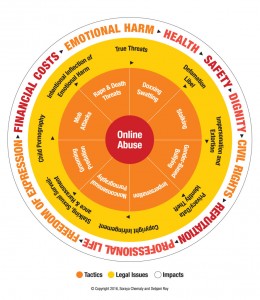In the article, Better Online Living through Content Moderation, Melissa King argues that the use of content control features benefit users by lessening the chance of negative responses to harmful or insulting content that may be seen online. Some examples of these controls are content/trigger warnings, block and ignore functions, blocklists, and privacy options (King, lines 1-2). The reason for these privacy precautions is to stop users from seeing content that may trigger PTSD, an anxiety attack, or other negative feelings. King describes these as valid reasons and goes on to state that, “In fact, there is no such thing as an invalid reason: nobody should be required to read or listen to content if they do not want to” (King, lines 7-9).
Although content controls are a positive feature, there are some people that disagree. King allows readers to see these controls from the negative perspective, but provides a valid argument against opinions like these. Those who are against content controls often perceive users that utilize them as weak or over sensitive (King, lines 10-11). Situations in which users are being attacked or bothered by online aggressors are thought of as the victim’s problem instead of the antagonist’s doing. Others think these users should just toughen up and be less sensitive, which goes hand in hand with the Exposure Theory. This theory is designed to put a stop to anxiety by slowly exposing the subject to the source (King, lines 27-28). However, this theory does not come in handy when it comes to content controls. The Exposure Theory is all about controlled exposure; the Internet has no control over how often users are attacked or disturbed by the content on their screens.
Another argument often made against content controls is that online harassment is not ‘real’ harassment and there is no actual threat (King, lines 44-45). Many think that pestering cannot cause PTSD. This disorder is usually associated with veterans, but King clarifies that, “…the fact is, threats of violence online can be a cause of PTSD in and of itself” (King, lines 48-49). King goes on to quote Caleb Lack, a clinical psychologist, who states that bullying has an impact on mental health and cyber bullying can have the same effect. Long time exposure to situations, such as online harassment, is threatening and can cause PTSD (King, lines 52-53). So, content controls play a large role in the prevention of these types of disorders.
Lastly, King touches on the subjects of blocklists and the frequency of online harassment being geared toward women. Blocklists are a more recent type of content control and were designed to try and eliminate users from being attacked by hate groups. Groups such as Gamergate use tactics to threaten users into silence (King, lines 80-81). From posting their personal information online to calling family members with threats, users need the protection of blocklists to eliminate this kind of distress. Women in ‘male-dominant’ professions are often targeted by hate groups and these sexist comments can lead to the development of PTSD (King, lines 93-96).
It is in instances such as these that content controls have no reason to be deprecated. It is in the victim’s best interest to utilize content controls to their advantage. King concludes that content controls are personally set and do not interfere with anyone else’s Internet freedom, other than the user that sets them. Telling people to ‘weather the storm’ when it comes to online abuse is ignorant and cannot be expected of everyone; users have the right to implement content controls and soften the blow of online attacks whenever need be (King, lines 130-133).
Work Cited
Melissa King. “Better Online Living through Content Moderation.” Magazine. Model View Culture, October 14, 2015. https://modelviewculture.com/pieces/better-online-living-through-content-moderation.

